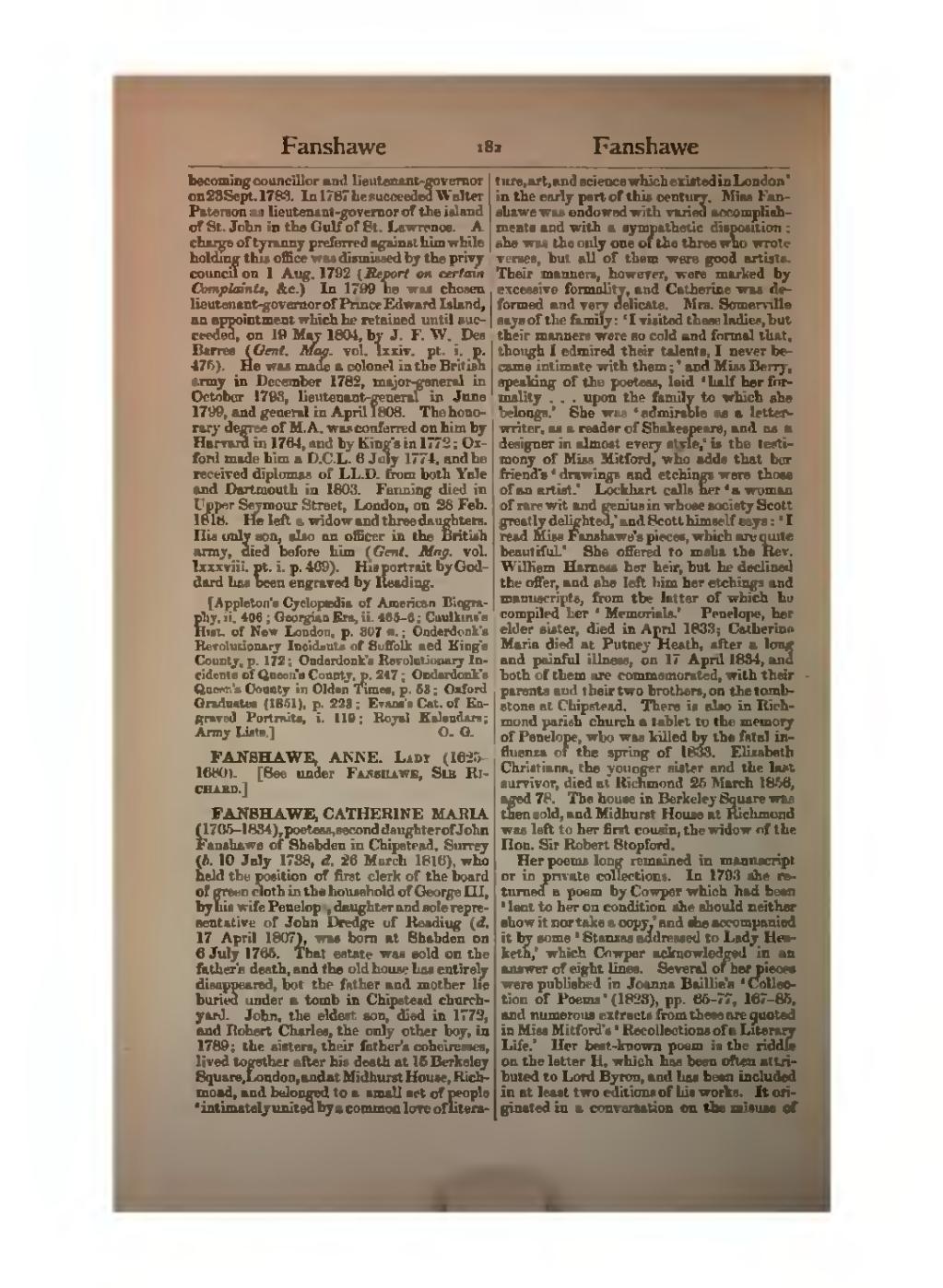becoming councillor and lieutenant-governor on 23 Sept. 1783. In 1787 he succeeded Walter Paterson as lieutenant-governor of Prince Edward Island. A charge of tyranny preferred against him while holding this office was dismissed by the privy council on 1 Aug. 1792 (Report on certain Complaints, &c.) He remained lieutenant-governor of Prince Edward Island until succeeded, on 19 May 1804, by J. F. W. Des Barres (Gent. Mag. vol. lxxiv. pt. i. p. 475). He was made a colonel in the British army in December 1782, major-general in October 1794, lieutenant-general in June 1799, and general in April 1808. The honorary degree of M.A. was conferred on him by Harvard College, Cambridge, Massachusetts, in 1764, and by King's College (afterwards Columbia), New York, in 1772; Oxford made him a D.C.L. 6 July 1774, and he received diplomas of LL.D. from both Yale and Dartmouth in 1803. Fanning died in Upper Seymour Street, London, on 28 Feb. 1818. He left a widow and three daughters. His only son, also an officer in the British army, died before him (Gent. Mag. vol. lxxxviii. pt. i. p. 469). His portrait by Goddard has been engraved by Reading.
[Appleton's Cyclopædia of American Biography, ii. 406; Georgian Era, ii. 465–6; Caulkins's Hist. of New London, p. 307 n.; Onderdonk's Revolutionary Incidents of Suffolk and King's County, p. 172; Onderdonk's Revolutionary Incidents of Queen's County, p. 247; Onderdonk's Queen's County in Olden Times, p. 53; Oxford Graduates (1851), p. 223; Evans's Cat. of Engraved Portraits, i. 119; Royal Kalendars; Army Lists.]
FANSHAWE, ANNE, Lady (1625–1680). [See under Fanshawe, Sir Richard.]
FANSHAWE, CATHERINE MARIA (1765–1834), poetess, second daughter of John Fanshawe of Shabden in Chipstead, Surrey (b. 10 July 1738, d. 26 March 1816), who held the position of first clerk of the board of green cloth in the household of George III, by his wife Penelope, daughter and sole representative of John Dredge of Reading (d. 17 April 1807), was born at Shabden on 6 July 1765. That estate was sold on the father's death, and the old house has entirely disappeared, but the father and mother lie buried under a tomb in Chipstead churchyard. John, the eldest son, died in 1772, and Robert Charles, the only other boy, in 1789; the sisters, their father's coheiresses, lived together after his death at 15 Berkeley Square, London, and at Midhurst House, Richmond, and belonged to a small set of people ‘intimately united by a common love of literature, art, and science which existed in London’ in the early part of this century. Miss Fanshawe was endowed with varied accomplishments and with a sympathetic disposition; she was the only one of the three who wrote verses, but all of them were good artists. Their manners, however, were marked by excessive formality, and Catherine was deformed and very delicate. Mrs. Somerville says of the family: ‘I visited these ladies, but their manners were so cold and formal that, though I admired their talents, I never became intimate with them;’ and Miss Berry, speaking of the poetess, laid ‘half her formality … upon the family to which she belongs.’ She was ‘admirable as a letter-writer, as a reader of Shakespeare, and as a designer in almost every style,’ is the testimony of Miss Mitford, who adds that her friend's ‘drawings and etchings were those of an artist.’ Lockhart calls her ‘a woman of rare wit and genius in whose society Scott greatly delighted,’ and Scott himself says: ‘I read Miss Fanshawe's pieces, which are quite beautiful.’ She offered to make the Rev. William Harness her heir, but he declined the offer, and she left him her etchings and manuscripts, from the latter of which he compiled her ‘Memorials.’ Penelope, her elder sister, died in April 1833; Catherine Maria died at Putney Heath, after a long and painful illness, on 17 April 1834, and both of them are commemorated, with their parents and their two brothers, on the tombstone at Chipstead. There is also in Richmond parish church a tablet to the memory of Penelope, who was killed by the fatal influenza of the spring of 1833. Elizabeth Christiana, the younger sister and the last survivor, died at Richmond 25 March 1856, aged 78. The house in Berkeley Square was then sold, and Midhurst House at Richmond was left to her first cousin, the widow of the Hon. Sir Robert Stopford.
Her poems long remained in manuscript or in private collections. In 1793 she returned a poem by Cowper which had been ‘lent to her on condition she should neither show it nor take a copy,’ and she accompanied it by some ‘Stanzas addressed to Lady Hesketh,’ which Cowper acknowledged in an answer of eight lines. Several of her pieces were published in Joanna Baillie's ‘Collection of Poems’ (1823), pp. 65–77, 167–85, and numerous extracts from these are quoted in Miss Mitford's ‘Recollections of a Literary Life.’ Her best-known poem is the riddle on the letter H, which has been often attributed to Lord Byron, and has been included in at least two editions of his works. It originated in a conversation on the misuse of
